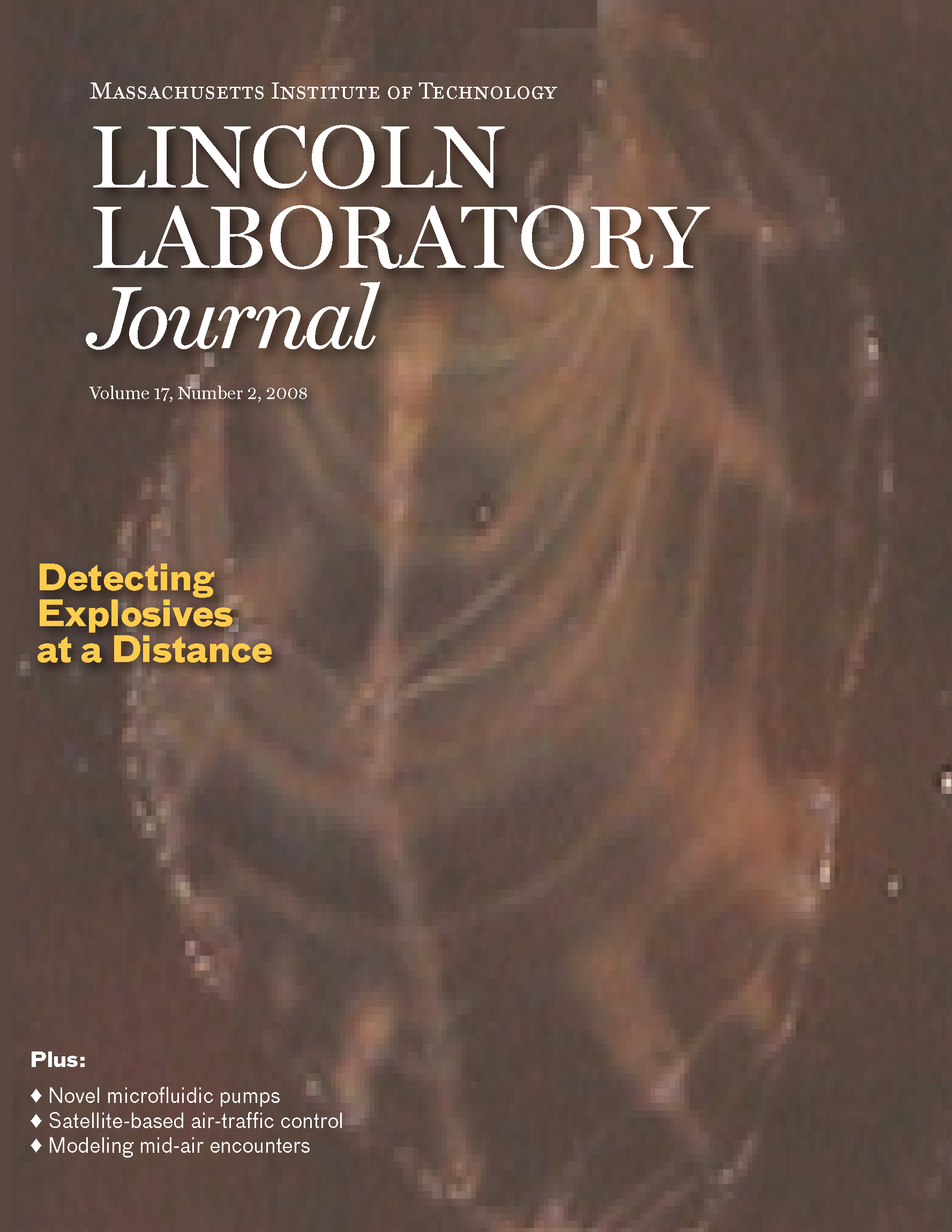Lincoln Laboratory Journal - Volume 17, Number 2

A Novel Method for Remotely Detecting Trace Explosives
By Charles M. Wynn, Stephen Palmacci, Roderick R. Kunz, and Mordechai Rothschild
The development of a technique with the ability to detect trace quantities of explosives at a distance is of critical importance. In numerous situations when explosive devices are prepared, transported, or otherwise handled, quantifiable amounts of the explosive material end up on surfaces. Rapid detection of these chemical residues in a noninvasive standoff manner would serve as an indicator for attempts at concealed assembly or transport of explosive materials and devices. We are investigating the use of a fluorescence-based technique to achieve the necessary detection sensitivity.
A Comprehensive Aircraft Encounter Model of the National Airspace System
By Mykel J. Kochenderfer, Leo P. Espindle, James K. Kuchar, and J. Daniel Griffith
Collision avoidance systems play an important role in the future of aviation safety. Before new technologies on board manned or unmanned aircraft are deployed, rigorous analysis using encounter simulations is required to prove system robustness. These simulations rely on models that accurately reflect the geometries and dynamics of aircraft encounters at close range. These types of encounter models have been developed by several organizations since the early 1980s. Lincoln Laboratory’s newer encounter models, however, provide a higher-fidelity representation of encounters, are based on substantially more radar data, leverage a theoretical framework for finding optimal model structures, and reflect recent changes in the airspace.
Automatic Dependent Surveillance-Broadcast in the Gulf of Mexico
By Steven D. Thompson and Katherine A. Sinclair
The Federal Aviation Administration is adopting Automatic Dependent Surveillance–Broadcast (ADS–B) to provide surveillance in the National Airspace System (NAS). Aircraft separation services are currently provided by a system of en route and terminal radars, and the performance of these radars in part dictates the separation distance required between aircraft. ADS–B is designed to provide comparable service in areas where no radar coverage exists. It will eventually be the primary surveillance source in the NAS, if it is proven to provide performance equal to or better than radar.
New Methods to Transport Fluids in Micro-Sized Devices
By Shaun Berry and Jakub Kedzierski
Applications of microfluidics require a self-contained, active pumping system in which the package size is comparable to the volume of fluid being transported. Over the past decade, several systems have been developed to address this issue, but either these systems have high power requirements or the microfabrication is too complex to be cost efficient. A recent effort at Lincoln Laboratory using an emerging technology called electrowetting has led to the development of several novel micropump concepts for pumping liquids continuously, as well as for pumping discrete volumes.
Lab Notes
- Auto-mation › A robotic car bedecked with Lincoln Laboratory sensors takes on DARPA's Urban Challenge.
- "Nano-urchins" Could Save Soldiers' Eyes › Novel materials darken quickly when hit by intense light, such as from a stray laser beam.
- Cruising the Energy Bands › New kind of atomic probe could be boon for quantum computing.
- Standing Guard › Protecting process control systems: Q&A with Robert Cunningham.
- Looking for a Reaction › A new DNA amplification method is better, faster, and cheaper than traditional tests.
- A Big Eye Sees Small Things › An upgrade to the Millstone radar antenna will ensure uninterrupted tracking of the ever more crowded geosynchronous orbit.
- Plugging the Right Holes › NetSPA software maps computer networks to find paths most vulnerable to hacking.
- Untangling the Friendly Skies › Computer recommendations could clear up some weather-caused airline delays.
- Good Vibrations › A different take on terahertz radiation can measure moving motors or beating hearts.
- Threat Detection › Cheap sensors plus mesh networking could yield an effective alarm system for biological and chemical attacks.
- Order from Chaos › Human factors engineering adds value to complex systems by making them seem simple to the user.
Looking Back
- Conceiving Collision Avoidance › Lincoln Laboratory proved that unfeasible was not the same as impossible.